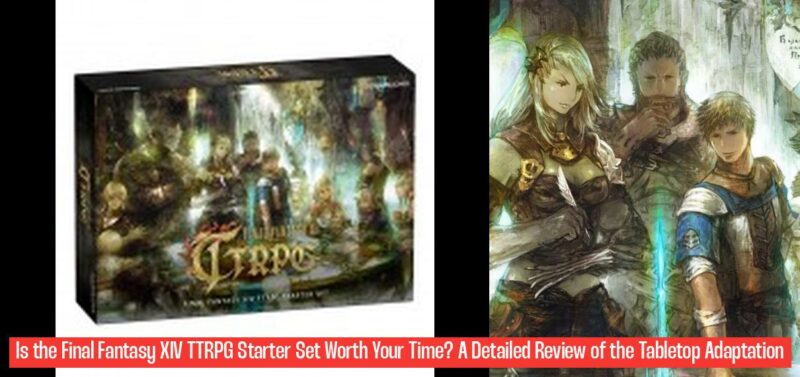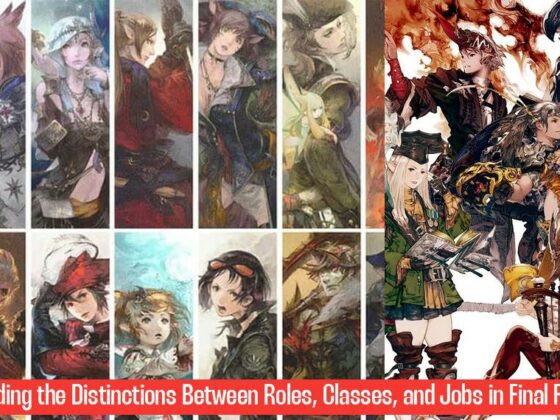Final Fantasy XIV TTRPG Starter Set review: “A Faithful, if Fleeting, Tabletop Adaptation”
It seems almost unbelievable that it took Final Fantasy, a video game series that emerged only a decade or so after Dungeons & Dragons revolutionized tabletop roleplaying, nearly 40 years to receive an official tabletop RPG adaptation. Even then, the Final Fantasy XIV TRPG Starter Set is merely a part of a complete Final Fantasy tabletop RPG, offering a barebones preview of a forthcoming standard rulebook for the TRPG – yet to be given a release date – based on the immensely popular MMO installment.
While the Starter Set feels somewhat limited in its scope – frustratingly so at times – what is present holds enough promise for those Final Fantasy XIV fans seeking to take a leap into the realm of tabletop RPGs for the first time. This is largely due to its highly faithful portrayal of the world of Eorzea and some unique ideas surrounding its MMO-inspired combat, making it much more than just another D&D clone.
Final Fantasy XIV TTRPG Starter Set Features & Design
This Starter Set is truly a “starter set” in the most extreme sense of the term, presenting two concise rule booklets – one for players and another for the Game Master running their adventures, encompassing three introductory scenarios. The box also includes four pre-generated character sheets based on FFXIV’s Warrior, Black Mage, White Mage, and Dragoon jobs. Additionally, the set boasts some attractive custom dice (color-coded for each class type: Healer, DPS, and Tank), paper maps, and cardboard tokens to represent attack zones, NPCs, and enemies.
At a price of $60 / £51 from the Square Enix store, it’s considered overpriced for a typical RPG box set, despite the good quality of the components. However, it aligns with the pricing patterns for merchandise from the Final Fantasy publisher.
Discover – Mystique’s Solo Comic: A Showdown with Nick Fury on the Horizon
The books clearly indicate their intended audience, with nearly the first half of the Player Book dedicated to a series of tutorials that guide players through examples of gameplay using a combination of comic strips and chat boxes. The rules and presentation are geared towards Final Fantasy XIV players who are new to tabletop RPGs, not seasoned D&D or Pathfinder veterans seeking a fantasy alternative.
While the rulebooks as a whole may lack some clarity in areas that experienced RPG rule-checkers might find frustrating, they effectively ease players into the fundamental aspects of gameplay.
This is facilitated by the RPG’s core gameplay mechanics, which utilize a straightforward set of rules centered around rolls of a 20-sided die, modified by a simple set of character traits such as Speed, Vitality, and Dexterity. However, don’t mistake it for another D&D-based d20 system; the dice math and overall complexity are significantly reduced, making this a much more relaxed and beginner-friendly experience for both learning and playing, with both advantages and drawbacks.
Final Fantasy XIV TTRPG Starter Set Gameplay
This light-touch approach is particularly evident in combat, the highlight of the system. Drawing direct inspiration from FFXIV’s MMO battles, combat revolves around the strategic use of skills to form chains of rotations. Players can execute one primary and one secondary action during their turn, as well as move – or sacrifice movement for an additional secondary action – with the opportunity to combo specific moves for a free action. They can also use instant abilities during other characters’ turns – both allies and enemies – to provide helpful protective spells or to stun an opponent preparing a damaging attack.
This dynamic system ensures all players remain actively engaged in the fight at all times.
Jobs function as expected from the MMO, with Tanks drawing enemies’ attention using Enmity before DPS chip away at their health while Healers provide support. One drawback is that the set’s encounters are explicitly designed for a “light party” of four players, with the less-than-ideal alternative of creating NPC companions, such as chocobos, to fill in for missing human players.
In another video game-inspired element, larger battles have dedicated rules for separate phases, transforming bosses into new forms while players see their limited abilities reset. Powerful limit breaks, meanwhile, become available at the GM’s discretion.
If a player dies, the rules recommend simply restarting the fight rather than implementing permadeath.
Next Steps
Once you’ve grasped the basics of this beginner box, you have a couple of options. First, there’s the Standard Rulebook, which delves deeper into mechanics and character creation. Next comes the Scenario & Gamemaster Guide to assist GMs in creating and running their own adventures. Premade scenarios are also included. Unfortunately, there’s no firm release date for either of these beyond a vague “coming soon.”
In a notable departure from rolling to hit in D&D, attacks always hit. However, dice rolls against an opponent’s normal or magical defense determine whether a “direct hit” lands, resulting in additional damage and/or effects, such as stunning an enemy or gaining a buff. This is a clever and satisfying rule that feels authentic to the constant stream of auto-attack damage in the MMO and overcomes the frustration of swinging and missing turn after turn in other tabletop RPGs.
The guaranteed damage also prevents combat from dragging on despite being a combat-focused game. In my group’s first session, we completed three combat encounters against multiple enemies in under three hours without the GM needing to manipulate health values behind the scenes or fights ending before everyone got a chance to attack.
As someone with hundreds of hours invested in FFXIV, who has also roleplayed for over a decade, I’ve rarely enjoyed purely mechanical combat in tabletop RPGs. While FFXIV is highly mechanical – leaving little room for narrative “theater of the mind” improvisation in characters’ skills – its familiarity from the MMO, speed, and ease of resolution, aided by details like rolling once to resolve attacks against groups, players determining their own turn order rather than rolling initiative, and critical hits simply doubling the number of damage dice rolled, meant I finally found enjoyment in maneuvering characters around on a grid map.
This enjoyment only intensified when enemies in later encounters started deploying more advanced area-of-effect attacks (including the dreaded stack marker) more frequently, requiring players to stay alert and utilize their skills carefully to avoid getting caught in the target area – just like in the MMO.
While the initial scenario is somewhat slow and straightforward, especially considering there are only three adventures total in the set, the later encounters begin to shake up the party’s tactics in a way that promises tremendous potential for challenging and complex encounters in the complete rules.
These scenarios directly tie into the main story quest of FFXIV, featuring familiar faces, places, and even plot points from A Realm Reborn. Non-FFXIV players might find themselves somewhat lost in the references to specific factions, locations, and individuals, even with some additional details provided in the book. This means it’s truly best enjoyed with a group of seasoned XIV fans who can appreciate its fidelity to the game.
That familiarity will also help overcome some of the shortcomings of the barebones rules themselves, which allow players to freely choose a species for their pre-made character (with no rules or modifiers attached) but fail to include a list of Eorzean inhabitants anywhere.
Considering character customization is a core aspect of XIV, it’s a shame that there are no specific gear effects or deeper leveling options outlined in the Starter Set. Players simply enter scenarios as pre-made characters at one of three different levels – 30, 40, or 50 – with a set list of skills and no element of armor or weapon modifiers whatsoever. This makes sense in terms of the MMO’s full hotbars and level-matching for duties, but it does mean that as a tabletop RPG, it currently lacks some of the player personalization and progression that contributes to immersive roleplaying.
Should You Buy the Final Fantasy XIV TTRPG Starter Set?
Final Fantasy XIV has become somewhat legendary and meme-ified for its generous free trial, which offers dozens of hours of gameplay spanning A Realm Reborn and the expansions Heavensward and Stormblood. Its tabletop adaptation feels comparatively stingy, at least in this Starter Set.
When its original gameplay ideas come together, this is a highly enjoyable and satisfying adaptation of MMO gameplay that feels authentic and fun in its own right, serving as an approachable adaptation that fans can readily embrace.
The speed and strategy of combat shine brightly, the jobs and quests feel true to their on-screen counterparts, and the rules are straightforward enough to grasp in a single session while still offering enough depth for players to feel engaged.
If anything, I just wish there was a bit more content – more scenarios, more character options (encouragingly, the game’s creators have since released a Bard job as free DLC), and more freedom to take the game beyond its limited, inflexible debut. Perhaps we’ve been spoiled by the video game, and that’s asking a bit much of a Starter Set. Regardless, what’s here is enough to have piqued my interest for the full rulebook. In that respect, perhaps this tease of what’s to come does exactly what it needs to.
Buy It If…
- ✅ You’re a Final Fantasy fan looking to take your first step into tabletop roleplaying.
- This is the first official Final Fantasy RPG, and it’s not a bad one at that. With simplified rules, scenarios, and mechanics directly inspired by the MMO, you’ll feel right at home quickly.
- ✅ You find Dungeons & Dragons a bit too rules-heavy with combat taking too long.
- You’ll still be rolling a d20 here, but adding up your modifiers is much easier. Combat flows quickly, with the thrill of dodging AOEs, and you’re always guaranteed to hit.
Don’t Buy It If…
- ❌ You haven’t played Final Fantasy XIV.
- You’ll be able to get by, but the jobs and scenarios in the Starter Set are so heavily reliant on Eorzea that it’s difficult to recommend over other fantasy RPGs if you’re not a XIV fanatic.
- ❌ You enjoy the character creation and customization of other TRPGs like D&D.
- The Starter Set is extremely limited on character options, with no gear, no progression system, and only four jobs to choose from in the box.
How We Tested the Final Fantasy XIV TTRPG Starter Set
Our reviewer served as Game Master for a full group of players, including a mix of Final Fantasy XIV fans and tabletop RPG regulars. They played the included scenario from the starter set.
For more information, check out our guide on how we test board games and tabletop RPGs or the GamesRadar+ review policy.
Looking for other recommendations? Don’t miss the best board games or these must-have board games for adults.
What does the Final Fantasy XIV TTRPG Starter Set include?
The Starter Set includes two rule booklets for players and Game Masters, three introductory scenarios, four pre-generated character sheets, custom dice, paper maps, and cardboard tokens.
Is the Final Fantasy XIV TTRPG Starter Set suitable for beginners?
Yes, the set is designed for Final Fantasy XIV players new to tabletop RPGs, offering tutorials and guidance through examples of gameplay.
What makes the Final Fantasy XIV TTRPG Starter Set unique?
The Starter Set stands out for its faithful portrayal of the world of Eorzea, unique ideas around MMO-inspired combat, and custom components like color-coded dice and tokens.
How does the pricing of the Final Fantasy XIV TTRPG Starter Set compare to other RPG box sets?
At $60 / £51, the set is considered overpriced for a typical RPG box set, but it aligns with pricing patterns for merchandise from the Final Fantasy publisher.



